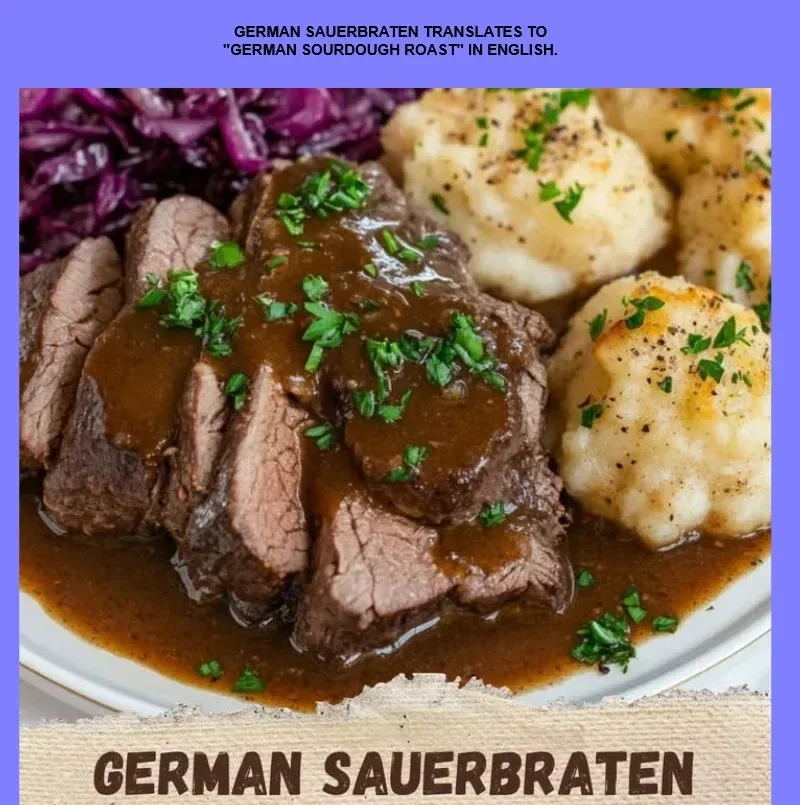German Sauerbraten translates to “German Sourdough Roast” in English.


Easy Traditional German Sauerbraten (German Sourdough Roast) — Homemade, Healthy Comfort Food
German Sauerbraten translates to "German Sourdough Roast" in English. I say that with a smile, because while many English speakers call it that, the more literal meaning is closer to “sour roast” — a nod to the tangy, wine-and-vinegar marinade that makes this a one-of-a-kind, slow-cooked comfort dish.
I first tasted Sauerbraten at my grandmother’s kitchen table on a rainy Sunday — the kind of meal that wraps around you like a blanket. The aroma of braised beef, warm spices, and a glossy, slightly sweet-tart gravy filled the house. It’s perfect for Sunday family dinners, holiday gatherings, or any weeknight you want something cozy and impressive without fuss. This easy, traditional, homemade version keeps the soul of the recipe while offering healthy swaps and time-saving tips.
🧂 Ingredients:
- 3–4 pounds beef roast (chuck, rump, or bottom round)
- 2 cups dry red wine (or extra beef broth for low-alcohol)
- 1 cup beef broth
- 1 cup red wine vinegar or apple cider vinegar
- 1 large onion, roughly chopped
- 2 carrots, roughly chopped
- 2 celery stalks, roughly chopped
- 3 cloves garlic, smashed
- 2 bay leaves
- 10 whole black peppercorns
- 6 whole cloves (or 1/2 tsp ground clove)
- 1 tbsp sugar or brown sugar (or maple syrup for a natural sweetener)
- 2 tbsp tomato paste (optional, for deeper color)
- Salt and freshly ground black pepper, to taste
- 2–3 tbsp cooking oil (olive oil or neutral oil)
- 8–10 gingersnap cookies, crushed (traditional thickener; see variations)
- Fresh parsley, chopped (for garnish)
Optional for marinade flavor boost: 1–2 tbsp juniper berries, 1 small strip of orange peel, or 1 tsp mustard seeds.
👩🍳 Directions:
- Prepare the marinade: In a large bowl, whisk together red wine, vinegar, beef broth, chopped onion, carrots, celery, garlic, bay leaves, peppercorns, cloves, and sugar. Add optional aromatics if using.
- Marinate the beef: Place the roast in a large nonreactive container or a zip-top bag and pour the marinade over it. Cover and refrigerate for 2–3 days, turning the roast once a day. (For a quicker version, marinate overnight — the flavors will be good but slightly less developed.)
- Strain and reserve: After marinating, remove the roast, pat it dry, and season with salt and pepper. Strain the marinade, reserving the liquid and the solids separately. Press the vegetables lightly to extract juices.
- Brown the roast: In a heavy Dutch oven or large ovenproof pot, heat oil over medium-high heat. Brown the roast on all sides (about 3–4 minutes per side) until a deep crust forms. Transfer the roast to a plate.
- Sauté the veg and add flavor: Add the strained vegetables to the pot and sauté for 4–5 minutes. Stir in tomato paste (if using) and cook 1 minute.
- Deglaze and simmer: Pour in the reserved marinade liquid, scraping up browned bits. Add the roast back to the pot and bring to a gentle simmer. Cover, reduce heat to low, and cook on the stovetop for 2.5–3 hours, or until the meat is fork-tender. Alternatively, bake covered at 325°F (160°C) for 2.5–3 hours.
- Finish the sauce: Remove the roast and keep warm. Strain the cooking liquid into a saucepan, pressing the vegetables to extract flavor. Simmer for 10–15 minutes to reduce. If desired, crumble gingersnaps into the sauce while whisking to thicken (start with 4–6 and add more to reach desired thickness). Simmer another 5 minutes until glossy. Season to taste with salt, pepper, and a splash of vinegar or sugar to balance.
- Serve: Slice the roast across the grain. Spoon hot sauce over the slices and garnish with chopped parsley. Enjoy with traditional sides like red cabbage and potato dumplings, mashed potatoes, or spaetzle.
Total active time: ~45 minutes (plus marinating). Cook time: 2.5–3 hours.
💡 Tips & Variations:
- Faster marinade: Use a vacuum-seal bag or poke holes in the roast to help the marinade penetrate; marinate overnight for decent flavor.
- Slow cooker: Brown meat, transfer to a slow cooker, add strained marinade and veggies, and cook on low for 6–8 hours.
- Pressure cooker/Instant Pot: Brown meat on sauté, add strained marinade, and cook at high pressure for 60–75 minutes with natural release.
- Gluten-free: Use gluten-free gingersnaps or thicken with a cornstarch slurry (mix 1 tbsp cornstarch with 2 tbsp cold water and whisk into simmering sauce).
- Low-carb/Keto: Skip gingersnaps; thicken the sauce with xanthan gum (a pinch whisked in) or reduce longer until thick. Serve with cauliflower mash instead of potatoes.
- Vegan twist: Use large portobello mushrooms, seitan, or seared tempeh in place of beef. Use vegetable broth and reduce simmer time; thicken with blended roasted vegetables or a bit of cornstarch.
- Healthier swaps: Use leaner cuts like eye of round and trim excess fat; replace some wine with extra broth; swap sugar for a small amount of maple syrup or omit entirely and adjust with a touch of balsamic glaze.
- Make-ahead: Sauerbraten often tastes better the next day. Reheat gently on low, adding a splash of broth if needed.
- Storage: Refrigerate leftovers in an airtight container for 3–4 days. Freeze sliced roast with sauce for up to 3 months.
Serving ideas: braised red cabbage, spaetzle, buttered egg noodles, roasted root vegetables, or creamy mashed potatoes.
🩺 Health & Lifestyle Tie-in:
This homemade Sauerbraten packs protein and, when you choose lean cuts, less saturated fat — a satisfying option for heart-healthy home cooking. Slow-cooked meals like this are also budget-friendly and time-efficient, supporting both physical health and financial well-being: cooking at home can lower grocery costs and reduce reliance on expensive processed foods or dining out, helping you save for bigger goals like better health insurance or family finances. Small choices in the kitchen add up over time.
❤️ Conclusion:
If you make this easy, traditional German Sauerbraten (German Sourdough Roast), I’d love to hear how it turned out — leave a comment, tag me in your photos, or drop a tip you used to make it your own. There’s something special about sharing a slow-cooked meal; it’s comfort that travels from my kitchen to yours.
#fblifestyle
Enjoy — and don’t forget to breathe in that incredible aroma while it cooks!


German Sourdough Roast
Ingredients
Method
- In a large bowl, whisk together red wine, vinegar, beef broth, chopped onion, carrots, celery, garlic, bay leaves, peppercorns, cloves, and sugar. Add optional aromatics if using.
- Place the roast in a large nonreactive container or a zip-top bag and pour the marinade over it. Cover and refrigerate for 2–3 days, turning the roast once a day.
- After marinating, remove the roast, pat it dry, and season with salt and pepper. Strain the marinade, reserving the liquid and the solids separately. Press the vegetables lightly to extract juices.
- In a heavy Dutch oven or large ovenproof pot, heat oil over medium-high heat. Brown the roast on all sides (about 3–4 minutes per side) until a deep crust forms. Transfer the roast to a plate.
- Add the strained vegetables to the pot and sauté for 4–5 minutes. Stir in tomato paste (if using) and cook 1 minute.
- Pour in the reserved marinade liquid, scraping up browned bits. Add the roast back to the pot and bring to a gentle simmer. Cover, reduce heat to low, and cook on the stovetop for 150–180 minutes, or until the meat is fork-tender. Alternatively, bake covered at 325°F (160°C) for 150–180 minutes.
- Remove the roast and keep warm. Strain the cooking liquid into a saucepan, pressing the vegetables to extract flavor. Simmer for 10–15 minutes to reduce. If desired, crumble gingersnaps into the sauce while whisking to thicken. Simmer another 5 minutes until glossy. Season to taste with salt, pepper, and a splash of vinegar or sugar to balance.
- Slice the roast across the grain. Spoon hot sauce over the slices and garnish with chopped parsley.
- Enjoy with traditional sides like red cabbage and potato dumplings, mashed potatoes, or spaetzle.











